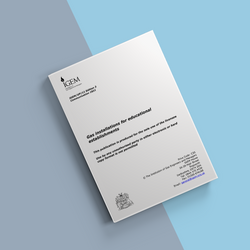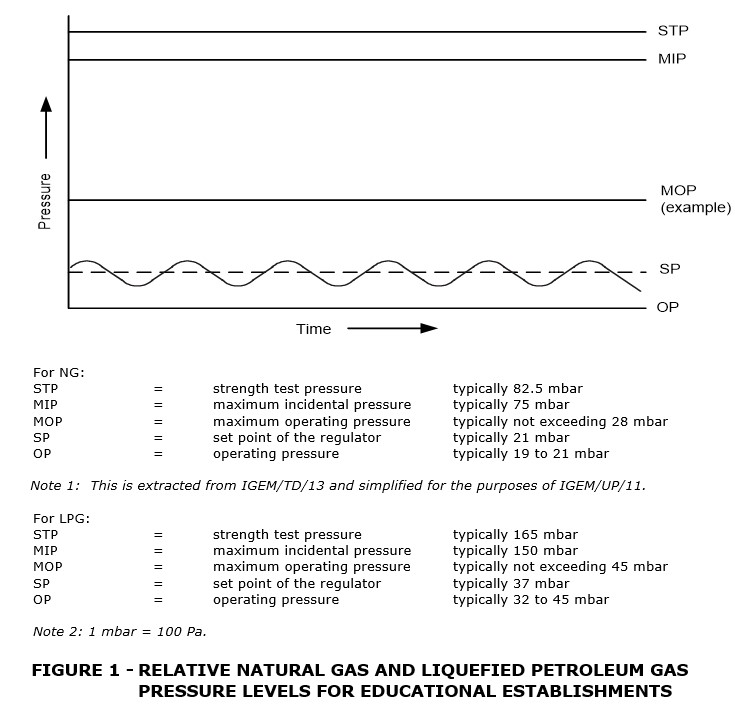IGEM/UP/11 Edition 3 - Gas installations for educational establishments

This standard covers the design, installation, operation and maintenance of gas pipework, systems and appliances used for teaching purposes in educational establishments, including schools, colleges, universities and training facilities. It applies to both new and existing pipework and appliances, covering 1st, 2nd and 3rd family gases supplied from either gas distribution systems or through independent LPG supplies. It contains details of:
Introduction
1.1 This Standard supersedes IGEM/UP/11 Edition 2, Communication 1744, which is obsolete.
1.2 This Standard has been drafted by a Panel appointed by the Institution of Gas Engineers and Manager’s (IGEM’s) Gas Utilisation Committee, subsequently approved by that Committee and has been approved by IGEM’s Technical Coordinating Committee on behalf of the Council of IGEM.
1.3 This Standard provides requirements for those concerned with the design, installation, operation and maintenance of gas pipework, systems and appliances in educational establishments, including schools; colleges; universities and training facilities. It brings together:
- guidance, interpretation and clarification of Legislation, Standards and Codes of Practice (CoPs) indicating the degree to which compliance is required, including those items that are applicable, and
- current best practice and design in the installation and use of Natural Gas (NG) and Liquefied Petroleum Gas (LPG) installations.
1.4 This Standard sets down the minimum requirements for safety in educational establishments, for architects, designers, science health and safety advisers, teaching and technical staff, in the operation of their systems and equipment. It is recognised that a risk assessment in some educational establishments may indicate a need for additional features such as larger valve handles, more easily accessible controls, signage in more than one language, in Braille or lower levels of carbon dioxide (CO2) within the teaching areas for specific health reasons. The responsibility for such measures lies with competent persons having responsibility for the design of the installation.
Note 1: It is recognised that specialist laboratory demonstration equipment may be used. In such cases, a risk assessment is needed and the general principles of this Standard may be applied to ensure safety.
Note 2: Current standards for ventilation in teaching areas are covered in DfES Building Bulletin 101 (BB 101).
1.5 IGEM/UP/11 Edition 3 has been prepared by IGEM’s Panel comprising representatives from the Council of Gas Detection and Environmental Monitoring (CoGDEM), Consortium of Local Education Authorities for the Provision of Science Services (CLEAPSS), Department for Education and Skills (DfES), Gas Safe Register, British Standards Institution (BSI) and consultants.
1.6 Responsibility for safety in local authority maintained establishments rests with the local authorities. In foundation schools, voluntary aided schools, academies, city technology colleges, universities and independent schools, such responsibility rests with governing bodies or proprietors.
In Private Finance Initiative (PFI) establishments safety in respect of the building and maintenance rests with the building provider, safety of the occupants rests with the user, but there are areas where both parties have to agree responsibilities. Any requirement in this Standard does not imply Government commitment to the provision of extra resources or funds.
1.7 This Standard reflects current best practice. As a general principle, this Standard does not duplicate national/international legislation or Standards. However, where appropriate, additional guidance; interpretation and clarification has been provided. Applicable references for Legislation, Standards etc. are listed in Appendix 2.
1.8 Terms such as maximum operating pressure (MOP) and operating pressure (OP) have been adopted to reflect gas pressure terminology used in European Standards. IGEM/G/4 defines these terms. These terms will arise in all relevant IGEM Standards in future and possibly in other Standards.
Note: For a new system of installation pipework, the onus is on the designer to establish both the maximum incidental pressure (MIP) and MOP. For an existing system of installation pipework, the onus is on the designer/owner of the system to ensure that any increase in pressure within the system will not result in OP exceeding MOP of the system and on the gas transporter/meter asset manager (GT/MAM) to ensure that any change in their pressure regimes due to fault conditions will not jeopardise the safety of the downstream system. This involves effective communication between the GTs/MAMs and system designers/owners (see Figure 1).

1.9 This Standard makes use of the terms “must”, “shall” and “should”, when prescribing particular procedures. Notwithstanding clause 1.13:
- the term “must” identifies a requirement by law in Great Britain (GB) at the time of publication
- the term “shall” prescribes a procedure which, it is intended, will be complied with in full and without deviation
- the term “should” prescribes a procedure which, it is intended, will be complied with unless, after prior consideration, deviation is considered to be acceptable.
Such terms may have different meanings when used in legislation, or Health and Safety Executive (HSE) Approved Code of Practice (ACoPs) or guidance, and reference needs to be made to such statutory Legislation or official guidance for information on legal obligations.
1.10 It is now widely accepted that the majority of accidents in industry are in some measure attributable to human as well as technical factors in the sense that actions by people initiated or contributed to the accidents, or people might have acted better to avert them.
It is therefore necessary to give proper consideration to the management of these human factors and the control of risk. To assist in this, it is recommended that due regard be paid to HSG48.
1.11 The primary responsibility for compliance with legal duties rests with the employer. The fact that certain employees, for example, “responsible engineers”, are allowed to exercise their professional judgement does not allow employers to abrogate their responsibilities. Employers must:
- have done everything to ensure, as far as is reasonably practicable, that there are no better protective measures that can be taken other than relying on the exercise of professional judgement
- have done everything to ensure, so far as is reasonably practicable, that “responsible engineers” have the skills, training, experience and personal qualities necessary for the proper exercise of professional judgement
- have systems and procedures in place to ensure that the exercise of professional judgement by “responsible engineers” is subject to appropriate monitoring and review
- not require “responsible engineers” to undertake tasks which would necessitate the exercise of professional judgement that is beyond their competence. There should be written procedures defining the extent to which “responsible engineers” can exercise their judgement. When “responsible engineers” are asked to undertake tasks which deviate from this, they should refer the matter for higher review.
These principles equally apply to designated/delegated employees, contractors, etc.
1.12 This Standard makes reference to “risk assessment”. Risk assessment is the assessment of health, safety and environmental aspects of a particular plant, process or activity (or part thereof) carried out using an established or specified format. Some assessments are specific requirements of health and safety legislation, for example the Dangerous Substances and Explosive Atmospheres Regulations (DSEAR), while others are carried out in order to assist in the management of safety and in discharging general legal responsibilities.
Note 1: Risk is defined as:
Likelihood of a specified undesired event occurring within a specified period or in specified circumstances, expressed as a frequency (rate of occurrence) or as a probability depending on the circumstances (see IGEM/G/4).
Note 2: Further guidance on risk assessment techniques can be found in IGEM/G/7.
1.13 Notwithstanding clause 1.9, this Standard does not attempt to make the use of any method or specification obligatory against the judgement of the responsible engineer. Where new and better techniques are developed and proved, they are to be adopted without waiting for modification to this Standard. Amendments to this Standard will be issued when necessary, and their publication will be announced in the Journal of IGEM and other publications as appropriate.
1.14 Requests for interpretation of this Standard in relation to matters within its scope, but not precisely covered by the current text, are to be addressed to Technical Services, IGEM, IGEM House, 26-28 High Street, Kegworth, Derbyshire, DE74 2DA or emailed to [email protected] and will be submitted to the relevant Committee for consideration and advice, but in the context that the final responsibility is that of the engineer concerned. If any advice is given by or on behalf of IGEM, this does not relieve the responsible engineer of any of his or her obligations.
1.15 This Standard was published in July 2018.
Scope
2.1 This Standard covers the design, installation, operation, and maintenance of gas pipework, systems and appliances in educational establishments including schools; colleges; universities and training facilities.
Note: IGEM/UP/1101 provides guidance on the operational issues for gas systems and appliances.
2.2 This Standard assumes general compliance with other relevant Standards such as IGEM/UP/2, IGE/UP/1 (or IGE/UP/1A or IGEM/UP/1B as appropriate), IGEM/UP/12, BS 6891, BS 6172 and BS 6173 and provide additional requirements as considered necessary in educational establishments.
2.3 This Standard applies to the installation, alteration, replacement, servicing and maintenance of new and existing pipework and appliances.
Note 1: Gas meter installations are not covered in this Standard. IGEM/GM/6, IGEM/GM/8 or BS 6400 apply, as appropriate.
Note 2: Standards rarely cover the retrospective issue of existing installations. They can, however, set a basis for consideration of performance upon which a risk assessment can be developed.
2.4 This Standard covers:
- piped gas supplied from gas distribution systems such as a NG distribution system or a LPG central bulk storage system
- piped gas supplied through independent LPG supplies i.e. either a cylinder or an individual bulk storage vessel
- portable LPG systems and appliances
- portable temporary LPG heaters.
2.5 This Standard applies to 1st, 2nd and 3rd family gases, as defined in BS EN 437.
Note: 1st, 2nd and 3rd family gases can be heavier than air. 2nd family gases include lighter than air gases such as NG and manufactured substitutes (hereafter referred to as NG). 3rd family gases include heavier than air gases such as LPG and sometimes further defined as propane or butane and in the vapour phase.
2.6 This Standard does not cover gas installations in an individual domestic
dwelling integral with an educational establishment. However, the installation of domestic gas appliances in an educational establishment itself is covered.
This Standard does not cover piped supplies to or from oxygen or acetylene systems. In such cases reference needs to be made to HSE Guidance HSG139. This Standard does not cover liquid fuel systems, appliances and flues. However many of the risks associated with gas systems will also apply to liquid fuel systems and similar standards of safety need to be applied. Advice for storage and use of bottled gases and other gases used for educational purposes are covered in CLEAPSS guidance.
2.7 This Standard does not cover the primary design requirements for central heating and domestic hot water plant for which reference to IGEM/UP/10 is necessary. However, it does address automatic isolation valves (AIVs) and other safety features for educational establishments.
2.8 This Standard does not cover central catering installations for which reference to BS 6173 is necessary.
2.9 This Standard does not cover the installation and use of specialist test and demonstration apparatus. For such apparatus, a competent person is required to ensure the apparatus is fit for purpose. In addition, such apparatus may only be operated by a competent person.
2.10 This Standard does not cover training and assessment facilities for gas operatives.
2.11 All pressures are gauge pressures unless otherwise stated.
2.12 Italicised text is informative and does not represent formal requirements.
2.13 Appendices are informative and do not represent formal requirements unless specifically referenced in the main sections via the prescriptive terms “must”, “shall” or “should”.
